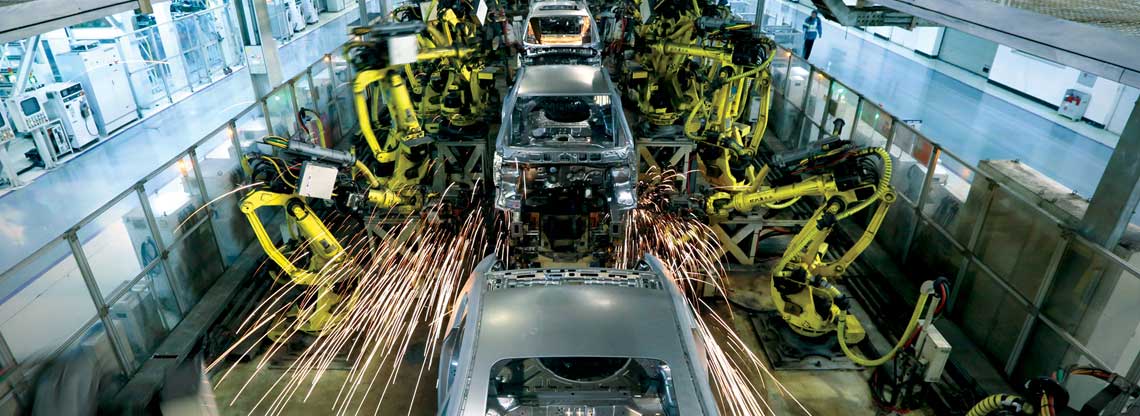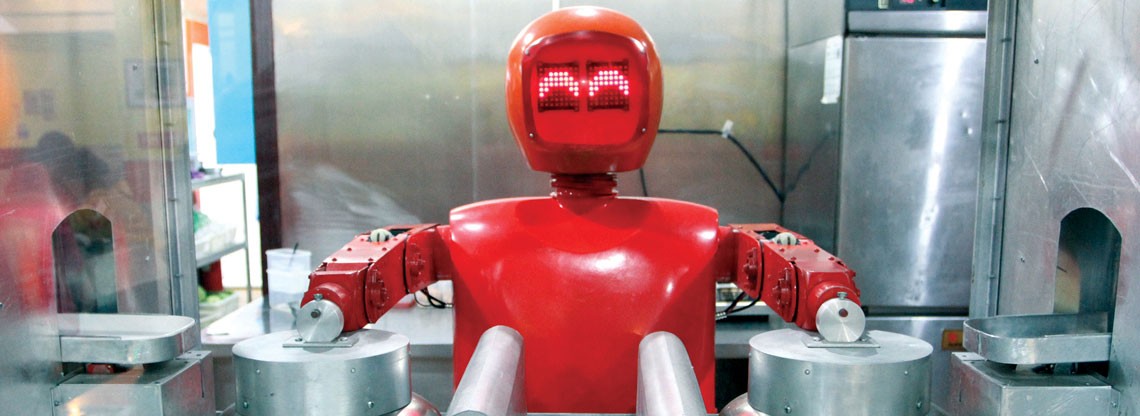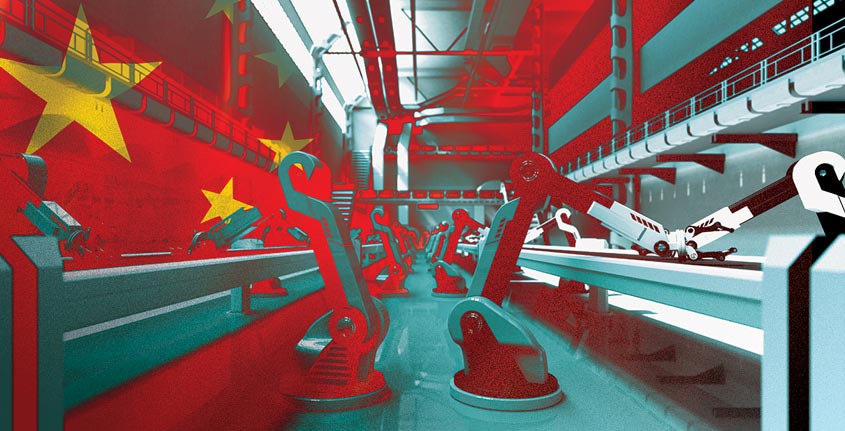Quick Hits
The Challenge: As global economies grow, it becomes harder to fill routine, relatively low-paying jobs at wages that make economic sense.
The Plan: Companies have increasingly looked to industrial automation, including robotics.
The Execution: China, for example, took delivery in 2014 of nearly 57,000 industrial robots—a quarter of those bought worldwide—an increase of more than 50 percent over the previous year.
The Result: Industrial robots will continue to do jobs that manufacturers cannot or prefer not to fill with human workers.
If you happen to be in Harbin, a town in northeastern China, someone will inevitably point you in the direction of the Robot Restaurant. It’s a must-see attraction—a restaurant where the food is cooked and served and even the dishwashing is done by a team of 20 robots. None has ever called in sick or gone on strike or demanded a pay raise.
A gimmick? Perhaps, although the restaurant has now been joined by at least two other entirely automated restaurants in mainland China. At one, in the town of Kunshan, the restaurant’s owner, Song Jugang, recently told the local newspaper that with each of his more than a dozen robots costing $6,200 (CNY 40,000)—the equivalent of a year’s salary for a Chinese waiter or chef—replacing human staff with machines was a no-brainer.
As a result, a dozen Chinese workers are out of a job.
Wrenching Change Ahead
This is a pattern of workplace innovation some believe is about to be reproduced throughout China’s industrial economy in a quest to improve productivity and reduce costs. Programmable machines are replacing not only service staff but thousands of factory production employees and perhaps higher-ranking supervisory staff. Chinese pay rates are rising, while the cost of personal and industrial robots is falling. As those two trends intersect, the outcome is likely to be one of wrenching change.
“What our Chinese customers tell us is that they just can’t find enough people to do the work, especially in electronics. If they do find them, it is a struggle to keep them.”—Steve Wyatt, global head of marketing and sales, ABB Robotics
Industrial robots make up the biggest segment of the robot market, and China is now by far the fastest-growing market for these machines. According to the International Federation of Robotics (IFR), which issues an annual report on the state of the global industrial robotics market, China took delivery last year of a quarter of all the 227,000 industrial robots purchased worldwide. Share on X That’s an increase of more than 50 percent from the year before, bringing the total of industrial robots installed and working in Chinese factories to 200,000.
That figure will grow, if evidence from China’s manufacturing heartland is anything to go by. The cradle of Chinese industrialization is the Pearl River Delta (PRD) in Guangdong Province, the enormous hinterland of Hong Kong, considered to be the world’s largest urban area, both in physical size and population. The PRD with its 120 million residents is where most of China’s advanced manufacturers are found, and it is also where automation is leading the transformation of the manufacturing economy.
“Automation is growing in automotive, in electronics, in food and beverages, metals processes, white goods and aerospace,” says Steve Wyatt, global head of marketing and sales for the largest robotics maker in China, ABB Robotics, a unit of Swiss industrial automation powerhouse ABB, which has 150,000 employees and 2014 revenue of $40 billion. “In this context, China is just a version of what is happening everywhere else in the world economy.”
China took delivery last year of a quarter of all the 227,000 industrial robots purchased worldwide. That’s an increase of more than 50 percent from the year before.
A Sign of the Times
In Foshan, one of the nine prefectures of Guangdong, the home appliance maker Midea Group Co. this year installed four robots that assemble the remote controls for products such as air conditioners. Building the remotes was previously the work of 14 production workers, plus two quality control supervisors. According to Midea, more robots will soon be installed to take over the work of the quality controllers. It’s a sign of the times. Chinese robots may not have ambitions of their own, but the companies investing in them plan to use machines to take over ever-more-sophisticated roles.

Midea has installed 800 robots in the last three years. Another 600 will join them this year. By the end of 2015, 20 percent of its workforce will have been replaced by machines.
For Midea, the business transformation is significant, but there are many other companies in China’s manufacturing heartland with even larger plans. Some are planning to reduce their reliance on human employees to a bare minimum of maintenance staff and rely on machines for all their value-added output.
Shenzhen Evenwin Precision Technology Co. in Dongguan, a manufacturer of electronic components for mobile phones and wireless network cards, has a workforce of 1,800. Soon that headcount will be reduced to 200, says the company, as it moves to a new factory where all production activities are automated.
Regional authorities in the PRD fully support and subsidize this shift to a robot economy. Guangdong province has said that over the next three years, it will spend $152 billion (CNY 943 billion) to support automation and Chinese makers of industrial robots.
In Guangdong alone, the provincial authorities plan to achieve 80 percent automation in the Delta’s factories by 2020, through state subsidy of robot purchases at nearly 2,000 of the PRD’s largest factories, according to a report in Bloomberg View earlier this year. If Chinese purchases of industrial robots continue at the present rate (and the introduction of state subsidies suggests that purchases may actually grow faster), there will be more than half a million industrial robots installed in Chinese factories by 2020.
“Global spending on industrial robots will have risen more than fourfold from 2010 to 2025, hitting $67 billion a year.”
What is happening in factories in China today is only one reflection of a worldwide trend. The replacement of humans by machines for repetitive or dangerous tasks has already happened throughout other parts of the industrialized world. This can be measured in “robot density,” or the number of industrial robots per 10,000 human manufacturing workers. Robot density is already over 1,000 in Japan, France, Germany, the United States and Italy, according to a recent report by the Boston Consulting Group (BCG). In China, robot density is about 30, according to the IFR, but rising very fast.
The reason Chinese authorities are happy to encourage the robotization trend that is almost certain to result in blue-collar job losses is simple: Companies can no longer fill those jobs at economically competitive rates. China is no longer a low-wage economy but a medium-wage economy. Average monthly wages in China are now $613, according to the International Labor Organization, compared to $121 in Cambodia and $197 in Vietnam.
Companies in the PRD are finding it increasingly difficult to fill blue-collar jobs as workers seek higher-paying and higher-status employment. Early this year, the labor department in Guangdong reported the province had a labor shortage of between 600,000 and 800,000. That is down from a shortage of about 2 million workers in 2010, but it is still a considerable shortfall for the region estimated to account for around 35 percent of all Chinese trade.
A Threat of Job Loss
So, what will happen to humans when robots take their jobs? In some cases, it won’t happen: Industrial robots will do jobs that companies cannot fill with humans. But that is only part of the story. As Midea’s and Shenzhen Evenwin’s experiences show, Chinese manufacturers are also shedding existing human jobs.
Foxconn, the Taiwanese company that is the world’s largest contract manufacturer of electronic products, promised it would install a million robots in its factories in Taiwan and mainland China by last year. That projection proved overly ambitious, but the company says its factories have now achieved automation rates of between 40 and 70 percent, displacing workers from high-value manufacturing jobs. China is beginning a process that will see many real jobs disappear.
Erik Brynjolfsson is a professor of management at the MIT Sloan School of Management and co-author of “The Second Machine Age: Work, Progress, and Prosperity in a Time of Brilliant Technologies,” an influential study of the impact of technology on employment and society. He believes the impact of automation may be bigger in China than in more advanced economies.
“Automation and robots will affect millions of jobs around the world, especially those involving routine information processing work and repetitive manual work,” Brynjolfsson says. “In many ways, China is even more in the bull’s-eye of this wave of automation than the United States and Europe. Many of China’s workers are still doing the kinds of simple tasks that have largely been automated already in countries with higher wages.”
To estimate how many industrial jobs will be lost to automation, Chinese companies use the rule of thumb that, at current costs, a single industrial robot takes the place of three workers. Assuming that is the case and given the current rate of Chinese industrial robot purchases, a reasonable estimate is that industrial robots will replace up to a million jobs over the next five years.
The total jobs lost may be somewhat higher, however, if automation grows more quickly. According to projections from BCG, global spending on industrial robots will have risen more than fourfold from 2010 to 2025 Share on X hitting $67 billion a year. Due to the falling price of automation products, it seems likely that the actual number of industrial robots purchased each year, including in China, will grow more than fourfold. Industrial robots will be the biggest part of the industry, accounting for about a quarter of all sales.
If the BCG forecasts of faster growth and wider application of automation are anywhere near correct, job losses in China attributable to automation could be more like 2 million by 2025. That may seem like a lot of jobs, but it is a very small proportion of the total working population in China. According to the Chinese National Bureau of Statistics, 769 million Chinese were in employment in 2013. The loss of 2 million jobs would represent no more than 0.26 percent of the country’s total employment.
What happens to those workers who do lose their jobs? Researchers have been puzzling over this for years, as fears of a jobless automated economy wax and wane. But China has been here before: In the 1990s as reforms of the state-dominated economy began to take hold, many of China’s state enterprises laid off workers in large numbers.
Something similar happened from 2003 to 2009 when market forces dictated large-scale job cuts in many Chinese businesses. Professor Hartmut Lehmann of the German Institute for the Study of Labor has collated data on labor transitions in emerging economies, including China. He found that while in the 1990s many Chinese workers displaced by restructuring did not find new jobs, in the subsequent decade there was a better record of adaptation. In this second period, about two-thirds of urban displaced workers found re-employment within a year, suggesting that the Chinese labor market has become more flexible.

A Silver Lining
So while automation is set to change the Chinese economy quite dramatically, it is unlikely to create a serious unemployment problem. On the contrary: According to Steve Wyatt of ABB Robotics, the biggest problem that the Chinese manufacturing economy faces is not a shortage of jobs but a shortage of workers. “What our Chinese customers tell us is that they just can’t find enough people to do the work, especially in electronics,” says Wyatt. “If they do find them, it is a struggle to keep them. They might find that 10 percent or 15 percent of their labor force just don’t turn up after returning home for the New Year holidays. On top of that, there is wage inflation, which is continuing. Clearly, automation can help with all that.”
Early this year, the labor department in Guangdong reported the province had a labor shortage of between 600,000 and 800,000.
Brynjolfsson of MIT says the beneficial effects of automation in China can greatly outweigh the destructive impact on jobs and may help create more rewarding occupations—though a positive outcome will ultimately depend on cooperation between Chinese entrepreneurs, workers, educators and policymakers. “Technology will continue to advance up the complexity ladder, pushing people into new jobs, many of which have not yet even been invented, and also replacing many existing professional jobs,” he says. “However, there are other dimensions where humans have an edge, including interpersonal skills. So new opportunities will emerge for work involving caring for others, motivating, selling, leadership, negotiation and mentoring.”
Wyatt agrees. “People in China have very different expectations than before,” he says. “Is your dream for your child that he or she will spend 10 hours a day polishing mobile phone cases in a factory? Clearly not. And that’s why people are not lining up for those jobs anymore. I mean, would you?” IQ






